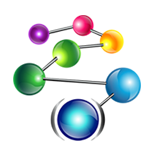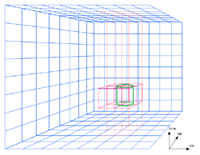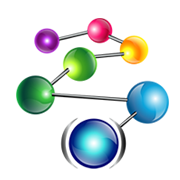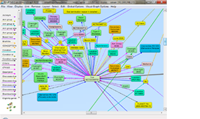In this issue
- Announcing AllegroGraph 5.0
- Free Webcast: Maximizing New Multi-dimensional Indexing for Complex Location Aware Applications with AllegroGraph v5.0
- Press Release: AllegroGraph 5.0 Unveils New Multi-dimensional Indexing for Complex Location Aware Applications
- Press Release: Franz Inc. Chief Scientist John Foderaro part of the UC-Berkeley RISC team receiving IEEE Milestone Recognition
- European Lisp Symposium, April 20-21, Goldsmiths University, London, UK
- Gruff v5.7 Now Available
- "Insider Threat Detection" - Webcast Recording, Slides, Technical Paper Now Available
- Follow us on Google Plus, Twitter, LinkedIn, and YouTube
- Training Schedule
Announcing AllegroGraph 5.0

AllegroGraph 5.0 delivers a New 3D and multi-dimensional geospatial functionality.
AllegroGraph has long supported two-dimensional encoding in both spherical and Cartesian systems. The 5.0 release includes a new implementation called nD for "N-Dimensional". It has powerful new capabilities, a simpler, more intuitive API, and automates some of the setup tasks for geospatial.
Although the term geospatial refers specifically to positions on or around the earth's surface, AllegroGraph supports a more-general notion of n-dimensional ordinates systems that could be used in fields such as semiconductor manufacturing and biology, to name a couple.
Additional New features include:- Update to new Sesame 2.7.x transactional semantics
- Update to new Apache Jena v2.6.x
- WebView query page enhancements: display of execution time and abort options
- SPARQL v1.1 support for Geospatial, Temporal, and Social Network Analytics
- The server supports new optional specific transaction "begin"
- Improved support for encrypted client connections
- Query Engine optimizations
- Support for Top Braid Composer 4.5
For additional information, see here
Free Webcast: Maximizing New Multi-dimensional Indexing for Complex Location Aware Applications with AllegroGraph v5.0

Wednesday, February 25, 10:00 AM Pacific
With the recent release of AllegroGraph v5.0's unique multi-dimensional indexing capabilities, Data Scientists are better able to answer complex, real world questions which today require the fusion of data in many dimensions.
AllegroGraph was the first Graph Database to offer advanced temporal and geospatial libraries. With this latest release, AllegroGraph again leads the industry in advanced event based data processing for customers in healthcare, telecom, agriculture, financial and intelligence applications. Although the industries are diverse, these AllegroGraph customers are driven by a common need to better answer complex, real world questions which today require the fusion of data in many dimensions.
Join us for this webcast to learn more about optimizing multidimensional queries like the following:
| Which geographic areas with an altitude greater than 500m and less than 2500m had a reduction in crop yield in August and which also had high humidity for at least 5 consecutive days in the month of April. |
To register for this webinar, see https://attendee.gotowebinar.com/register/6846160092191734785
Press Release: AllegroGraph 5.0 Unveils New Multi-dimensional Indexing for Complex Location Aware Applications

February 9, 2015 Franz, Inc., the leading supplier of Semantic Graph Database technology, today announced AllegroGraph 5.0 with unique multi-dimensional indexing capabilities. Data Scientists can think of these new multi-dimensional indices as similar to OLAP data cubes or HyperCubes but with the powerful dynamic data linking of a Graph Database.
AllegroGraph was the first Graph Database to offer advanced temporal and geospatial libraries. With this latest release AllegroGraph again leads the industry with multi-dimensional event based data processing for solutions across a diverse customer base including; healthcare, telecom, agriculture, financial and intelligence applications. Although the industries are diverse, AllegroGraph users are driven by a common need to better answer complex, real world questions which today require the fusion of data in many dimensions...
To view the entire press release, see here
Press Release: Franz Inc. Chief Scientist John Foderaro part of the UC-Berkeley RISC team receiving IEEE Milestone Recognition
 February 2, 2015 UC-Berkeley will receive IEEE Milestone recognition for their RISC Project on Feb 12, 2015. The UC-Berkeley RISC milestone plaque will be unveiled at 3:30 PM in the lobby on the 3rd floor of Soda Hall, Berkeley's Computer Science building. Speakers will include IEEE 2015 President Howard Michel, Professor David Patterson, and several others. UC-Berkeley students designed and built the first VLSI reduced instruction-set computer in 1981...
February 2, 2015 UC-Berkeley will receive IEEE Milestone recognition for their RISC Project on Feb 12, 2015. The UC-Berkeley RISC milestone plaque will be unveiled at 3:30 PM in the lobby on the 3rd floor of Soda Hall, Berkeley's Computer Science building. Speakers will include IEEE 2015 President Howard Michel, Professor David Patterson, and several others. UC-Berkeley students designed and built the first VLSI reduced instruction-set computer in 1981...
Read the full press release here
European Lisp Symposium, April 20-21, Goldsmiths University, London, UK

The purpose of the European Lisp Symposium is to provide a forum for the discussion and dissemination of all aspects of design, implementationand application of any of the Lisp and Lisp-inspired dialects, including Common Lisp, Scheme, Emacs Lisp, AutoLisp, ISLISP, Dylan, Clojure, ACL2, ECMAScript, Racket, SKILL, Hop and so on. We encourage everyone interested in Lisp to participate.
Submission Deadline: February 22
Early Registration Deadline: March 29
For additional conference information, see here
Gruff v5.7 - Now Available!

New Features include:
- Blank nodes will now be included in the set of recently-accessed nodes to refetch in future sessions.
- The new option "Visual Graph Options | Node and Link Spacing | Show All Alignment" can be toggled on to show all of the nodes in the graph that are currently aligned with each other.
- The two new options "Relax Syntax When Loading Triples" and "Continue on Error When Loading Triples" on the Miscellaneous child menu of the Global Options menu allow loading n-triples and n-quads file that contain invalid RDF syntax on some lines.
- A sometimes bad delay has been removed in the displaying of results in the query view after the query itself is done.
- "File | Roll Back and Refresh" is now applicable when browsing a SPARQL endpoint.
- "Display | Display Some Sample Triples" should no longer display zero triples for some stores, and should generally display a more interesting set of triples than before.
- You can now move the selected node in the graph view and graphical query view by single pixels by holding down the control key and pressing the arrow keys. Holding down the shift key as well moves by twelve pixels each time instead of by one.
- You can now cancel the dialog for opening a store without the previous store being closed.
- Numerous Enhancements and Optimizations
See the full list of new features and improvements in the release notes
"Insider Threat Detection" - Webcast recording, Slides, Technical paper now available

Insiders are one of the top categories of data breaches according to recent reports by the FBI, Forrester Research and Verizon. In just the last year, high profile data breaches at Target, AT&T, and Morgan Stanley show that no organization is immune and all organizations must take steps to identify and protect themselves from insider threats.
In this webcast, Haystax describes an analytic approach that enables the continuous risk monitoring of insider threat based on the fusion of high and low frequency entity-related events via temporal relevance models and a probabilistic risk model. Haystax begins by providing an overview of their approach and the challenges faced when integrating events of widely disparate frequency. Next, they describe two forms of event temporal relevance they use to enable the model to fuse infrequent events (e.g. public records life events) with high frequency events (e.g. network activity). Finally, Haystax describes how they've used Franz's Allegro Common Lisp, Allegro Prolog, and AllegroGraph, with Norsys Netica to create a practical implementation of our analytic approach suitable for practical use.
The recorded webcast, slides, and technical paper are available here
Follow us on Google Plus, Twitter, LinkedIn, and YouTube
Training Schedule
 BECOME ALLEGRO CERTIFIED - To obtain your Allegro CL Certification enroll in our LIVE Program which offers developers an opportunity to learn and improve their Lisp programming skills from the comfort of their home or office while interacting with the Franz instructor.
BECOME ALLEGRO CERTIFIED - To obtain your Allegro CL Certification enroll in our LIVE Program which offers developers an opportunity to learn and improve their Lisp programming skills from the comfort of their home or office while interacting with the Franz instructor.
Lisp Programming Series Level I: Basic Lisp Essentials - February 11, 18, 25
Lisp Programming Series Level II: Specialized Components of Lisp - March 4, 11, 18
For additional information and to register, see here.



